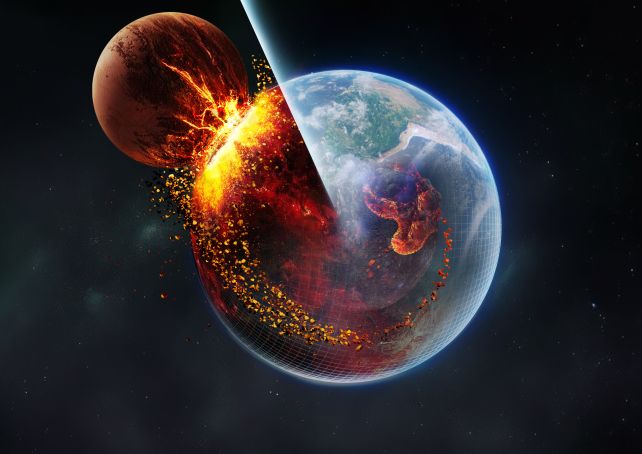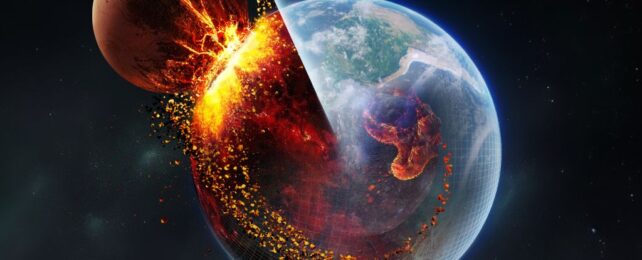Some 4.5 billion years or so ago, scientists believe, something big smacked into Earth and knocked it ass over teakettle.
The result was a bunch of debris, hurled into space, swirling around until it formed the Moon. Of the big object, thought to be the size of Mars, and named Theia, nothing much was left. Or so we thought.
Researchers from China, the US, and the UK have uncovered evidence that chunks of Theia ended up inside the Moon. And evidence also now suggests that chunks of Theia ended up inside Earth, too.
If that's the case, the giant impact hypothesis could solve a mystery that has bothered scientists for more than a decade: the presence of dense, continent-sized blobs of material, buried deep under Earth's mantle some 2,900 kilometers (1,800 miles) down, curved around its core.
"Our findings challenge the traditional notion that the giant impact led to the homogenization of the early Earth," says Hongping Deng of the Shanghai Astronomical Observatory (SHAO) of the Chinese Academy of Sciences.
"Instead, the Moon-forming giant impact appears to be the origin of the early mantle's heterogeneity and marks the starting point for the Earth's geological evolution over the course of 4.5 billion years."

The blobs that wrap around Earth's core are known as large low-shear-velocity provinces, or LLVPs. We know about them because seismic waves that travel through Earth from quakes move differently through different materials.
It's through seismic data that scientists have been able to obtain detailed maps of the LLVPs: large, dense regions at the core-mantle boundary, one under Africa, the other under the Pacific Ocean.
Scientists have heretofore proposed that the LLVPs are generated by some sort of internal Earth process, such as remnants of old tectonic slabs, or spots of higher temperature, or a magma ocean at the base of the mantle.
But the team behind this latest finding thought something else might have contributed to the formation of the LLVPs: Theia.
Previous numerical simulations have suggested that most of Theia ended up incorporated into the Moon, and only trace amounts remained inside Earth. But that might not necessarily be the case.
So, for several years, the researchers have been investigating the possibility that a large amount of Theia got stuck inside Earth, where it remains to this day, bothering scientists.
They conducted a series of computer simulations of the Theia impact, and observed the effects that had on their simulated Earth. And they found several signs that the giant impact may have left lasting traces on Earth's composition.

The first is the stratification of Earth's mantle. In the simulations, Earth and Theia material mixed in the upper mantle in a liquid magma ocean, while the lower mantle remained more solid, and predominantly silicate Earth material. This stratification, based on seismic data, may still exist today.
The second is the LLVPs. The team found that chunks of Theian material, just tens of kilometers across, could have sunk to the core-mantle boundary. There, they accumulate, growing into the LLVPs.
Approximately 2 to 3 percent of Earth's mass, the researchers found, could have come from Theia. And the LLVP material is expected to be between 2 and 3.5 percent denser than the mantle of Earth, and richer in iron.
This is good news, because it means there's a way to test it.
"In most of the Moon-forming impact simulations, most of the lunar materials come from the impactor, so we expect future missions can get lunar mantle rocks and compare that with the mantle blobs to see if they share the same chemical signatures," the study's lead author, geophysicist Qian Yuan of Caltech, tells ScienceAlert.
If this is the case, that gives us a new set of tools for understanding our planet's history and formation, and the history and the formation of the Solar System.
And, in turn, that could help us understand other worlds, and the chance of habitability, out there in the wider galaxy.
We have found no exoplanets exactly like Earth in the Milky Way. The giant impact could be one reason Earth is the way it is.
"The ancient Moon-forming collision could have a long-lasting effect for Earth's whole evolution," Yuan says, "so it might be one fundamental factor why Earth is geologically different from other rocky planets."
The research has been published in Nature.
